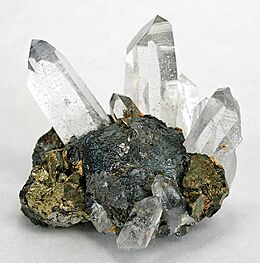Stannite facts for kids
Quick facts for kids Stannite |
|
|---|---|
 |
|
| General | |
| Category | Sulfide mineral |
| Formula (repeating unit) |
Cu2FeSnS4 |
| Strunz classification | 2.CB.15a |
| Crystal symmetry | I42m |
| Unit cell | a = 5.4432, c = 10.7299 [Å]; Z = 2 |
| Identification | |
| Color | Steel-gray to iron-black, may tarnish blue |
| Crystal habit | Rarely as pseudo-octahedral crystals also massive, granular, and disseminated |
| Crystal system | Tetragonal |
| Twinning | Penetration twins on {102} |
| Cleavage | Indistinct on {110} and {001} |
| Fracture | Uneven |
| Mohs scale hardness | 4 |
| Luster | Metallic |
| Streak | Black |
| Diaphaneity | Opaque |
| Specific gravity | 4.3 – 4.5 |
Stannite is a mineral that contains copper, iron, tin, and sulfur. It belongs to a group of minerals called sulfides.
Contents
What is Stannite Made Of?
Stannite has a special chemical formula: Cu2FeSnS4. This means it is made of copper (Cu), iron (Fe), tin (Sn), and sulfur (S). Sometimes, you can also find zinc mixed with the iron. Very tiny amounts of germanium might be there too.
Why is Stannite Important?
Stannite is important because it is a source of tin. About 28% of stannite is tin. It also has about 13% iron, 30% copper, and 30% sulfur. Tin is a useful metal for many things, like making cans and electronics.
Where is Stannite Found?
You can find stannite deep underground. It forms in cracks in rocks where hot, mineral-rich water has flowed. These places are called hydrothermal vein deposits. Stannite is often found with other minerals. Some of these include chalcopyrite, sphalerite, tetrahedrite, arsenopyrite, pyrite, cassiterite, and wolframite.
The History of Stannite
Stannite is sometimes called bell metal ore. This is because tin is a key ingredient in making bell metal. People believe that finding a lot of tin in Cornwall, England, helped more bells get made. The name 'Stannite' comes from the Latin word stannum, which means tin. Scientists first described this mineral in 1797. They found it in a place called Wheal Rock in St. Agnes, Cornwall, England.
See also
- Kesterite

